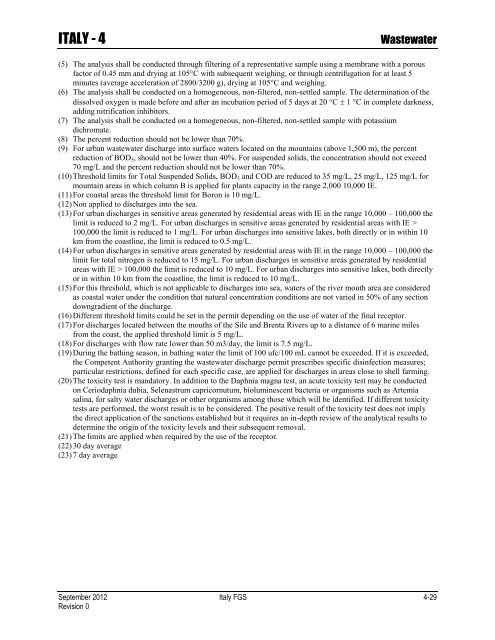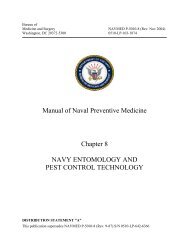ENVIRONMENTAL FINAL GOVERNING STANDARDS ITALY
ENVIRONMENTAL FINAL GOVERNING STANDARDS ITALY
ENVIRONMENTAL FINAL GOVERNING STANDARDS ITALY
You also want an ePaper? Increase the reach of your titles
YUMPU automatically turns print PDFs into web optimized ePapers that Google loves.
<strong>ITALY</strong> - 4 Wastewater<br />
(5) The analysis shall be conducted through filtering of a representative sample using a membrane with a porous<br />
factor of 0.45 mm and drying at 105°C with subsequent weighing, or through centrifugation for at least 5<br />
minutes (average acceleration of 2800/3200 g), drying at 105°C and weighing.<br />
(6) The analysis shall be conducted on a homogeneous, non-filtered, non-settled sample. The determination of the<br />
dissolved oxygen is made before and after an incubation period of 5 days at 20 °C 1 °C in complete darkness,<br />
adding nitrification inhibitors.<br />
(7) The analysis shall be conducted on a homogeneous, non-filtered, non-settled sample with potassium<br />
dichromate.<br />
(8) The percent reduction should not be lower than 70%.<br />
(9) For urban wastewater discharge into surface waters located on the mountains (above 1,500 m), the percent<br />
reduction of BOD5, should not be lower than 40%. For suspended solids, the concentration should not exceed<br />
70 mg/L and the percent reduction should not be lower than 70%.<br />
(10) Threshold limits for Total Suspended Solids, BOD5 and COD are reduced to 35 mg/L, 25 mg/L, 125 mg/L for<br />
mountain areas in which column B is applied for plants capacity in the range 2,000 10,000 IE.<br />
(11) For coastal areas the threshold limit for Boron is 10 mg/L.<br />
(12) Non applied to discharges into the sea.<br />
(13) For urban discharges in sensitive areas generated by residential areas with IE in the range 10,000 – 100,000 the<br />
limit is reduced to 2 mg/L. For urban discharges in sensitive areas generated by residential areas with IE ><br />
100,000 the limit is reduced to 1 mg/L. For urban discharges into sensitive lakes, both directly or in within 10<br />
km from the coastline, the limit is reduced to 0.5 mg/L.<br />
(14) For urban discharges in sensitive areas generated by residential areas with IE in the range 10,000 – 100,000 the<br />
limit for total nitrogen is reduced to 15 mg/L. For urban discharges in sensitive areas generated by residential<br />
areas with IE > 100,000 the limit is reduced to 10 mg/L. For urban discharges into sensitive lakes, both directly<br />
or in within 10 km from the coastline, the limit is reduced to 10 mg/L.<br />
(15) For this threshold, which is not applicable to discharges into sea, waters of the river mouth area are considered<br />
as coastal water under the condition that natural concentration conditions are not varied in 50% of any section<br />
downgradient of the discharge.<br />
(16) Different threshold limits could be set in the permit depending on the use of water of the final receptor.<br />
(17) For discharges located between the mouths of the Sile and Brenta Rivers up to a distance of 6 marine miles<br />
from the coast, the applied threshold limit is 5 mg/L.<br />
(18) For discharges with flow rate lower than 50 m3/day, the limit is 7.5 mg/L.<br />
(19) During the bathing season, in bathing water the limit of 100 ufc/100 mL cannot be exceeded. If it is exceeded,<br />
the Competent Authority granting the wastewater discharge permit prescribes specific disinfection measures;<br />
particular restrictions, defined for each specific case, are applied for discharges in areas close to shell farming.<br />
(20) The toxicity test is mandatory. In addition to the Daphnia magna test, an acute toxicity test may be conducted<br />
on Ceriodaphnia dubia, Selenastrum capricornutum, bioluminescent bacteria or organisms such as Artemia<br />
salina, for salty water discharges or other organisms among those which will be identified. If different toxicity<br />
tests are performed, the worst result is to be considered. The positive result of the toxicity test does not imply<br />
the direct application of the sanctions established but it requires an in-depth review of the analytical results to<br />
determine the origin of the toxicity levels and their subsequent removal.<br />
(21) The limits are applied when required by the use of the receptor.<br />
(22) 30 day average<br />
(23) 7 day average<br />
September 2012 Italy FGS 4-29<br />
Revision 0
















